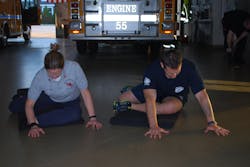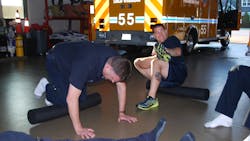I was recently partaking of a high-metabolic-demand group exercise class with a casual acquaintance. After one particularly hard round of the countdown, I expressed my displeasure with the amount of time it was taking my heart to recover to the appropriate zone. Without missing a beat, my comrade joked, “You need to REST with more intensity.” My mouth dropped open and I could not even respond. That simple utterance was the single most silly, yet profound statement that I had recently heard about exercise. This layperson had boiled down a hot topic of firefighter fitness to a simple lesson without even realizing it.
Managing stress—humans vs. zebras
The autonomic nervous system (ANS) consists of two divisions: the sympathetic (fight and flight) and the para-sympathetic (rest and digest or feed and breed). The issue is that both portions of the ANS feed input into the body’s other systems. Having appropriate input of these systems allows for balance and homeostasis within the body. Heart rate, blood pressure, dilation of the pupils and even bowel movements are under the control of the ANS. Have you ever felt like you were going to lose control of your bowels during a period of intense stress? You can thank sympathetic nervous system override.
In his book “Why Zebras Don’t Get Ulcers,” author Robert Sapolsky addresses stressors on the human body.1 Briefly, there are acute stressors and chronic stressors. Unfortunately, as humans, we tend to take what should be an acute stress (“that jerk just cut me off in traffic and I almost wrecked my car!”) to a state of chronic stress (stomach in knots about that same jerk a week later). Zebras, on the other hand, just do their zebra things. They avoid the jackals and lions as necessary and don’t dwell on it after. They also don’t stress about buying a nicer house.
Taking this a step further, firefighters experience various forms of stress input above and beyond the general population. One of the greatest stressors to firefighters is sleep deprivation. Studies show that men who sleep less than six hours per night are significantly more likely to die prematurely than those who slept longer, even when controlling for factors such as disease, weight and alcohol use.2 Sleep is one of the most important factors for brain and body health and repair, and firefighters are likely deprived no less than every third day (or whenever their schedule falls). So merely going to work almost guarantees the stressor of sleep deprivation. Add to that the adrenaline dump every time the tones go off and the possibility of life-and-death actions and you’ve got a recipe for a stress stew.
Over-training or under-recovering?
What these firefighters fail to recognize is that the human body doesn’t discern between stressors. The stress of working a code on a child in a tiny bathroom is the same as the stress of 12 rounds of 100-meter sprints and 25 air squats for time. Likewise, the stress of a newborn at home and aging parents who just moved into your house is the same stress as a combat challenge run-through. It’s all stress, and too much of it is going to drive the sympathetic nervous system output even higher than is optimal.
For ideal body functioning, the sympathetic nervous system should kick in when necessary (grabbing your child before they wander into traffic) and then downregulate until called into action again. Chronic sympathetic overdrive wreaks havoc in the body and leads to a general inability to relax and concentrate as well as feelings of nervousness or jitteriness. Sympathetic overdrive has even been implicated in the development and progression of metabolic syndrome, a cluster of conditions that increases the risk of heart disease, stroke and diabetes.3
Let’s zoom out briefly. When prescribing an exercise program for anyone, the answer to the question “what should I do for best results?” should always be “it depends.” Best results depend on many factors, including (but not limited to) goals, age, gender, health status, previous injury, previous experience and the list goes on and on. Additional factors: How much stress are you under? How much sleep do you get? What is your nutritional status? The latter three questions are especially important considerations when programming for firefighters.
In the strength and conditioning world, we argue about whether it’s even possible to over-train an athlete. Some experts argue that over-training isn’t an issue and the real problem is under-recovering. Regardless, and the data is clear on this front: One can only benefit from the level of training from which one can effectively recover.
Improving your recovery
With all this in mind, we can make the following assumptions related to firefighters: 1) They are sleep deprived; 2) their sympathetic nervous system is in overdrive; and 3) their nutrition is not quite on point. Therefore, recovery modalities will take on increased importance.
Following are some simple topics and techniques you can address today for yourself or your crews that will pay huge dividends:
· Sleep: Your stress levels and sleep are intimately related. “Stress levels influence both the quantity and quality of sleep. This, in turn creates a vicious cycle because the less well rested we are, the less resilient we become in the face of stress.”2
· Meditation or breathing/relaxation: Increased sympathetic nervous system input yields an increase in ventilation rate. However, by intentionally slowing ventilatory rate, we can increase para-sympathetic nervous system tone. Mom was right when she told you to take a deep breath (or 10) before you blew your top. If you want to take this a step further, apps such as Headspace, Calm or Insight have been game-changers for clients.
· Soft tissue work or NormaTec massage: The simple act of foam-rolling, getting a massage or sitting in compression boots serves to downregulate the sympathetic nervous system and restore balance.
· Low-intensity training: Substitute an easy walk or hike for one of your high-intensity days. This is especially useful on the day after a shift day. Save the higher-intensity training for your interim day between getting off shift and going back to shift.
· Nutrition/lowering inflammation: Lowering inflammation in your body through intelligent nutrition choices decreases stress on the body indirectly. Mom was right again: Cut out the junk, eat your vegetables, and knock it off with the mindless snacking.
“Better is better”
To wrap up, I’d like to quote an outstanding physical therapist and great friend, C. Shante Colfield: “More is not better. Better is better.” This is especially true in terms of balancing exercise intensity and recovery modalities. Take a deep breath or 10 and stay safe out there.
References
1. Sapolsky, Robert M. “Why Zebras Don't Get Ulcers.” S. MartinÌs Griffin, 2004.
2. Sullivan, John P., and Chris Parker. “The Brain Always Wins: Improving Your Life through Better Brain Management.” Urbane Publications, 2016.
3. Grassi, G. Hypertens Res. 2006 Nov; 29(11):839-47. Review.
About the Author

Annette Zapp
Annette Zapp is a 14-year veteran of the fire service, currently serving as a full-time lieutenant for the Lisle-Woodridge, IL, Fire Protection District near Chicago. She has a master’s degree in biochemistry and molecular biology, and is credentialed through the National Strength and Conditioning Association (NSCA) as a certified strength and conditioning specialist (CSCS) and a tactical strength and conditioning facilitator (TSAC-F). She is also a PN-1 coach and a certified sports nutritionist from the International Society of Sports Nutrition (CISSN). Zapp is the owner of A to Z Fitness and Nutrition and the co-founder of Transformation Engineers, an online coaching platform.

